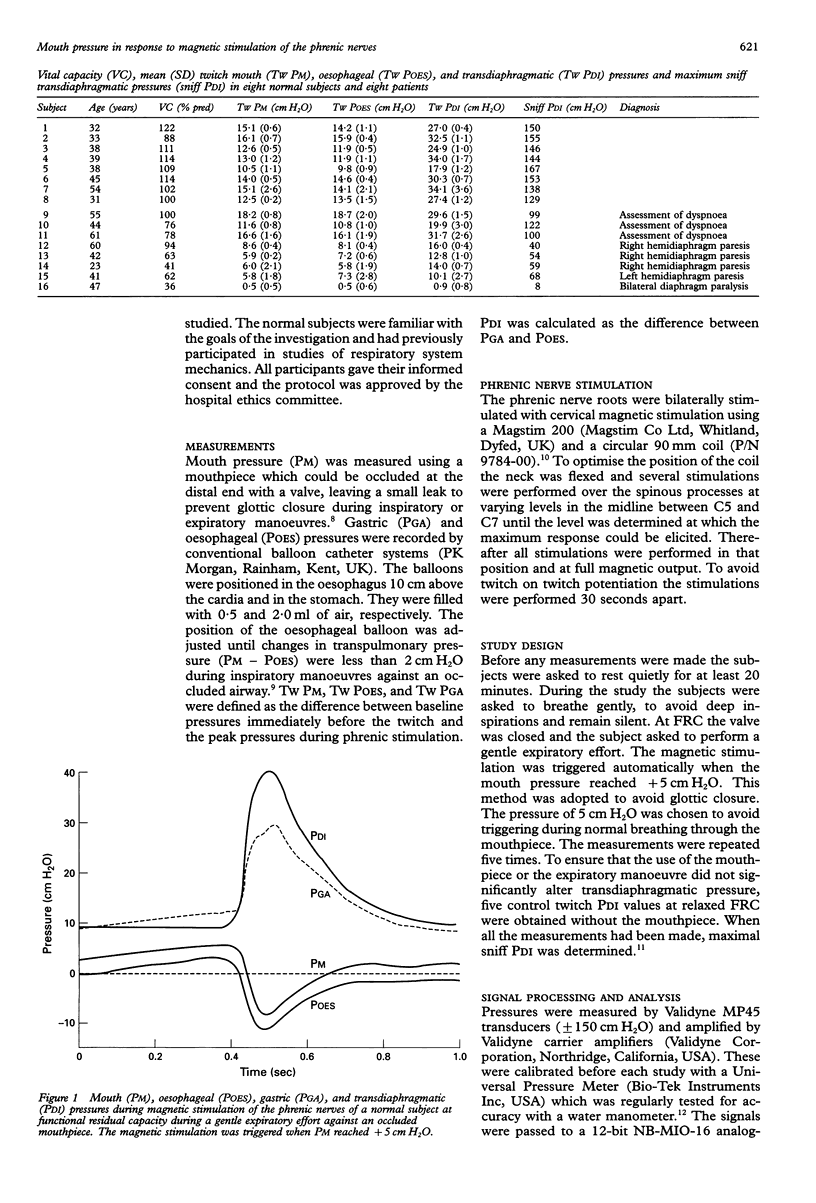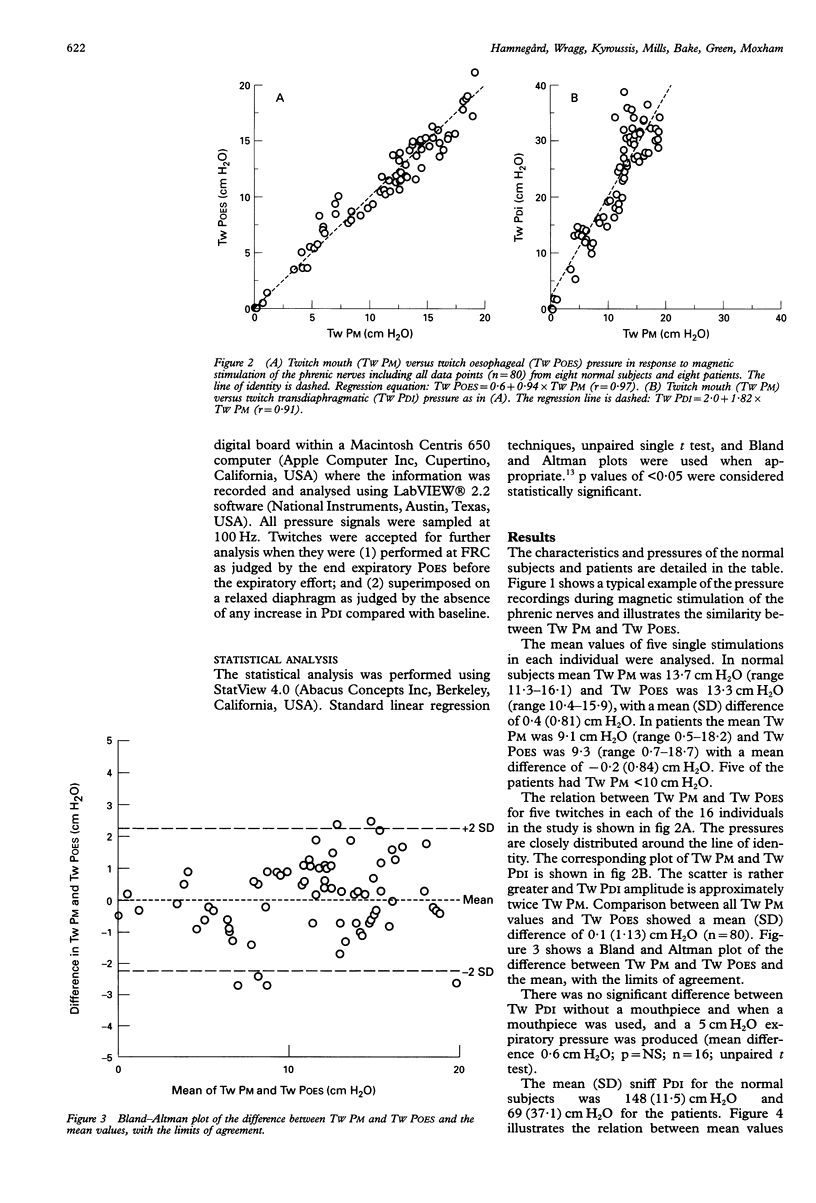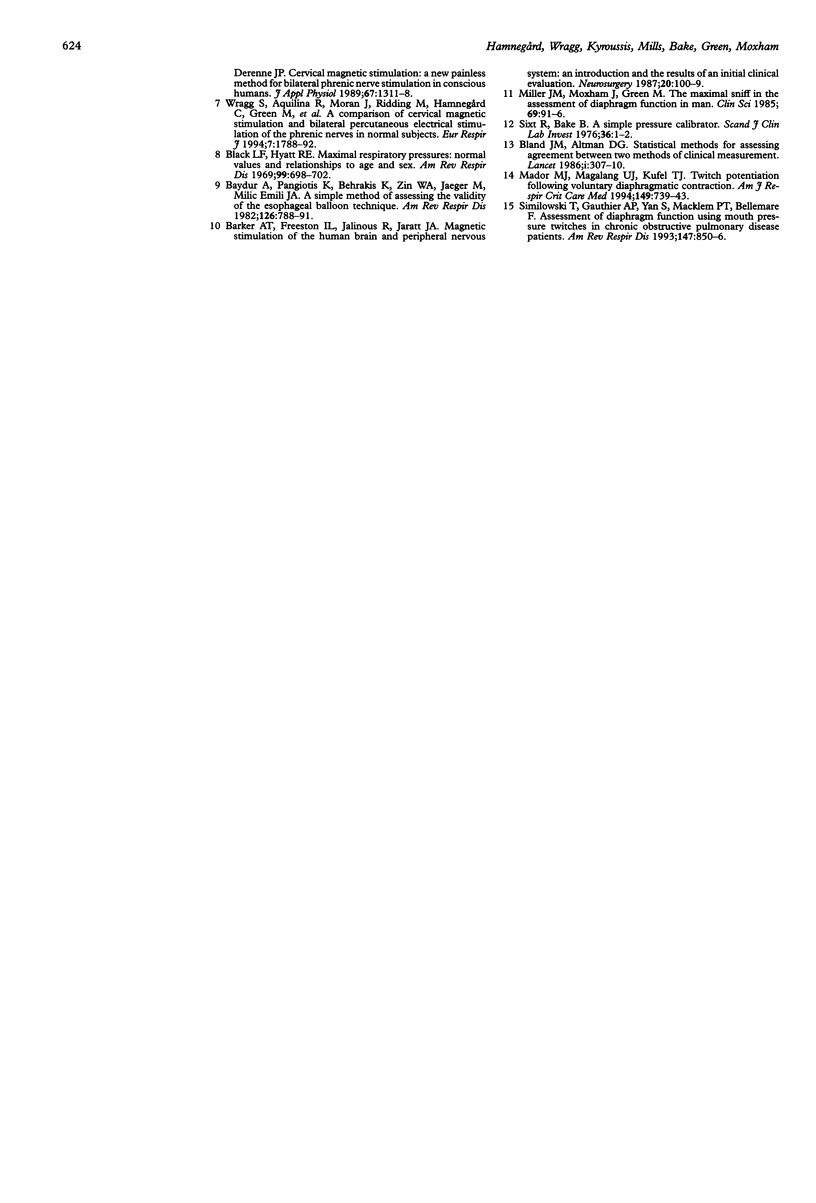Abstract
BACKGROUND--Diaphragm strength can be assessed by the measurement of gastric (TW PGA), oesophageal (TW POES), and transdiaphragmatic (TW PDI) pressure in response to phrenic nerve stimulation. However, this requires the passage of two balloon catheters. A less invasive method of assessing diaphragm contractility during stimulation of the phrenic nerves would be of clinical value. A study was undertaken to determine whether pressure measured at the mouth (TW PM) during magnetic stimulation of the phrenic nerves accurately reflects TW POES, and to investigate the relations between TW PM and TW PDI; and also to see whether glottic closure and twitch potentiation can be avoided during these measurements. METHODS--Eight normal subjects and eight patients with suspected respiratory muscle weakness without lung disease were studied. To prevent glottic closure magnetic stimulation of the phrenic nerves was performed at functional residual capacity during a gentle expiratory effort against an occluded airway incorporating a small leak. TW PDI, TW POES, and TW PM were recorded. Care was taken to avoid potentiation of the diaphragm. RESULTS--In normal subjects mean TW PM was 13.7 cm H2O (range 11.3-16.1) and TW POES was 13.3 cm H2O (range 10.4-15.9) with a mean (SD) difference of 0.4 (0.81) cm H2O. In patients mean TW PM was 9.1 cm H2O (range 0.5-18.2) and TW POES was 9.3 (range 0.7-18.7) with a mean (SD) difference of -0.2 (0.84) cm H2O. The relation between TW PM and TW PDI was less close but was well described by a linear function. In patients with diaphragm weakness (low sniff PDI) TW PM was < 10 cm H2O. CONCLUSIONS--TW PM reliably reflects TW POES and can be used to predict TW PDI in normal subjects and patients without lung disease. TW PM may therefore be a promising non-invasive, non-volitional technique for the assessment of diaphragm strength.
Full text
PDF




Selected References
These references are in PubMed. This may not be the complete list of references from this article.
- Barker A. T., Freeston I. L., Jalinous R., Jarratt J. A. Magnetic stimulation of the human brain and peripheral nervous system: an introduction and the results of an initial clinical evaluation. Neurosurgery. 1987 Jan;20(1):100–109. doi: 10.1097/00006123-198701000-00024. [DOI] [PubMed] [Google Scholar]
- Baydur A., Behrakis P. K., Zin W. A., Jaeger M., Milic-Emili J. A simple method for assessing the validity of the esophageal balloon technique. Am Rev Respir Dis. 1982 Nov;126(5):788–791. doi: 10.1164/arrd.1982.126.5.788. [DOI] [PubMed] [Google Scholar]
- Bellemare F., Bigland-Ritchie B. Assessment of human diaphragm strength and activation using phrenic nerve stimulation. Respir Physiol. 1984 Dec;58(3):263–277. doi: 10.1016/0034-5687(84)90003-3. [DOI] [PubMed] [Google Scholar]
- Black L. F., Hyatt R. E. Maximal respiratory pressures: normal values and relationship to age and sex. Am Rev Respir Dis. 1969 May;99(5):696–702. doi: 10.1164/arrd.1969.99.5.696. [DOI] [PubMed] [Google Scholar]
- Bland J. M., Altman D. G. Statistical methods for assessing agreement between two methods of clinical measurement. Lancet. 1986 Feb 8;1(8476):307–310. [PubMed] [Google Scholar]
- Carè A., Mattia G., Montesoro E., Parolini I., Russo G., Colombo M. P., Peschle C. c-fes expression in ontogenetic development and hematopoietic differentiation. Oncogene. 1994 Mar;9(3):739–747. [PubMed] [Google Scholar]
- Mador M. J., Magalang U. J., Kufel T. J. Twitch potentiation following voluntary diaphragmatic contraction. Am J Respir Crit Care Med. 1994 Mar;149(3 Pt 1):739–743. doi: 10.1164/ajrccm.149.3.8118645. [DOI] [PubMed] [Google Scholar]
- Mier A., Brophy C., Moxham J., Green M. Phrenic nerve stimulation in normal subjects and in patients with diaphragmatic weakness. Thorax. 1987 Nov;42(11):885–888. doi: 10.1136/thx.42.11.885. [DOI] [PMC free article] [PubMed] [Google Scholar]
- Miller J. M., Moxham J., Green M. The maximal sniff in the assessment of diaphragm function in man. Clin Sci (Lond) 1985 Jul;69(1):91–96. doi: 10.1042/cs0690091. [DOI] [PubMed] [Google Scholar]
- Similowski T., Fleury B., Launois S., Cathala H. P., Bouche P., Derenne J. P. Cervical magnetic stimulation: a new painless method for bilateral phrenic nerve stimulation in conscious humans. J Appl Physiol (1985) 1989 Oct;67(4):1311–1318. doi: 10.1152/jappl.1989.67.4.1311. [DOI] [PubMed] [Google Scholar]
- Similowski T., Fleury B., Launois S., Cathala H. P., Bouche P., Derenne J. P. Cervical magnetic stimulation: a new painless method for bilateral phrenic nerve stimulation in conscious humans. J Appl Physiol (1985) 1989 Oct;67(4):1311–1318. doi: 10.1152/jappl.1989.67.4.1311. [DOI] [PubMed] [Google Scholar]
- Similowski T., Gauthier A. P., Yan S., Macklem P. T., Bellemare F. Assessment of diaphragm function using mouth pressure twitches in chronic obstructive pulmonary disease patients. Am Rev Respir Dis. 1993 Apr;147(4):850–856. doi: 10.1164/ajrccm/147.4.850. [DOI] [PubMed] [Google Scholar]
- Wragg S., Aquilina R., Moran J., Ridding M., Hamnegard C., Fearn T., Green M., Moxham J. Comparison of cervical magnetic stimulation and bilateral percutaneous electrical stimulation of the phrenic nerves in normal subjects. Eur Respir J. 1994 Oct;7(10):1788–1792. doi: 10.1183/09031936.94.07101788. [DOI] [PubMed] [Google Scholar]
- Wragg S., Hamnegard C., Road J., Kyroussis D., Moran J., Green M., Moxham J. Potentiation of diaphragmatic twitch after voluntary contraction in normal subjects. Thorax. 1994 Dec;49(12):1234–1237. doi: 10.1136/thx.49.12.1234. [DOI] [PMC free article] [PubMed] [Google Scholar]
- Yan S., Gauthier A. P., Similowski T., Macklem P. T., Bellemare F. Evaluation of human diaphragm contractility using mouth pressure twitches. Am Rev Respir Dis. 1992 May;145(5):1064–1069. doi: 10.1164/ajrccm/145.5.1064. [DOI] [PubMed] [Google Scholar]


